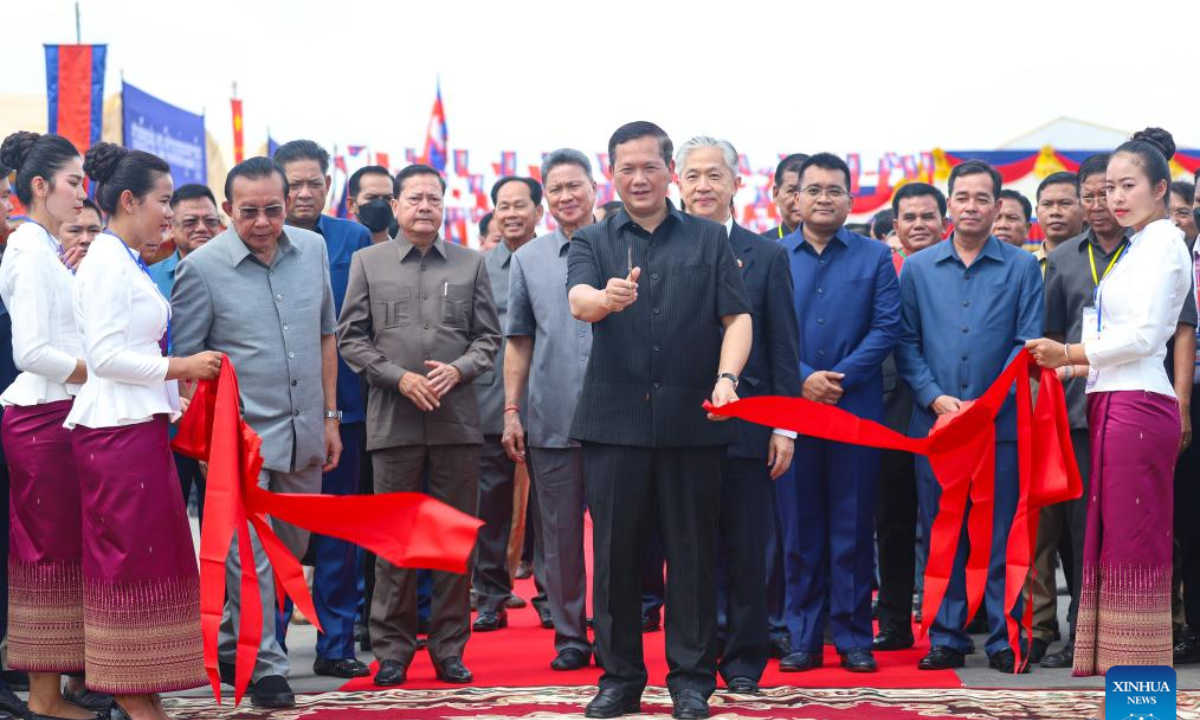China, Cambodia join hands to build a better Lancang-Mekong

Aerial photo taken on March 11, 2021 shows the eighth Cambodia-China Friendship Bridge across the Mekong River, connecting Kampong Cham province and Tboung Khmum province in southeastern Cambodia. (Shanghai Construction Group/Handout via Xinhua)
Chinese President Xi Jinping is paying a state visit to Cambodia from Thursday to Friday. This year also marks the 10th anniversary of the first Lancang-Mekong Cooperation (LMC) Foreign Ministers' Meeting. For both China and Cambodia, the LMC serves as a crucial platform to deepen bilateral cooperation, injecting strong momentum and vitality into the comprehensive and practical partnership between the two countries, as well as the entire Mekong sub-region. The further deepening of relations between China and Cambodia will also drive closer cooperation under the framework of the LMC and regional mechanisms.
As the first sub-regional cooperation mechanism in the basin jointly established by six nations - China, Cambodia, Laos, Myanmar, Thailand and Vietnam, the LMC has made remarkable strides across various fields over the past 10 years, emerging as a "golden platform" for regional collaboration.
Over the past decade, the LMC mechanism has focused on three pillars of cooperation: political and security issues, economic and sustainable development, and social, cultural and people-to-people exchanges. It has centered on five priority areas: connectivity, production capacity, cross-border economic cooperation, water resources, agriculture and poverty reduction. The six member countries, upholding the Lancang-Mekong concept of "development first, equality, practicality and efficiency, openness and inclusiveness," have established a high-level dialogue mechanism that includes biennial leaders' meetings and annual foreign ministers' meetings.
China and Cambodia have been vital participants and active drivers of the LMC from the very beginning, contributing significantly to the development and progress of this mechanism. Under the LMC framework, the two countries have cultivated a multidimensional partnership spanning various key sectors including both hard and soft connectivity, security, agriculture, energy, water governance, rural development, cultural heritage preservation and tourism.
With China's continued support, significant strides have been made in infrastructure development, including the construction of roads, bridges and transportation networks that enhance connectivity across Cambodia. Noticeably, the Siem Reap Angkor International Airport and the Phnom Penh-Sihanoukville Expressway have significantly boosted logistics and personnel flow, contributing to economic growth.
Through targeted investments, China has supported Cambodia's transition toward modern, sustainable agricultural practices, focusing on increasing productivity, improving irrigation systems and enhancing the capacity of local farmers. In parallel, the two countries have jointly worked to improve water resource management. China has assisted Cambodia through capacity building and technology transfer, modernizing irrigation systems, increasing investment in water infrastructure and expanding hydrometeorological networks to efficiently improve water management capacity.
As a result, people, especially in rural areas, now have better access to clean water for both agricultural and domestic use.
In addition, in the digital realm, China has supported Cambodia's efforts to promote e-commerce platforms, digital literacy and ICT infrastructure, thereby laying the groundwork for an inclusive digital economy. In the area of green development, the two countries have committed to enhancing cooperation in renewable energy, including hydropower and photovoltaics, and other clean energy sources, to explore stable and reliable energy cooperation solutions.
In summary, the cooperation between China and Cambodia over the years has positively responded to the practical development needs of the people in the Lancang-Mekong sub-region. Cambodia has always been a major participant and promoter of the LMC, and the two countries have achieved fruitful results in the LMC cooperation.
In the next phase, China and Cambodia will enhance bilateral cooperation and coordination within the LMC framework. Looking to the future, the Lancang-Mekong sub-region holds remarkable transformative potential. China, Cambodia and other Mekong countries will come together to enhance collaboration and integration across various sectors.
The LMC will continue to present a promising path for dynamic development and shared prosperity among the Lancang-Mekong countries by further uniting nations united with a shared vision of sustainable development, enhancing regional connectivity, and fostering mutual understanding and respect.
Lim Menghour is Director of the Mekong Centre for Strategic Studies of the Asian Vision Institute in Cambodia and Director of the Global Center for Mekong Studies (GCMS) Cambodia Center. Du Lan is Deputy Director of the Department of Asia-Pacific Studies of China Institute of International Studies and General Secretary of GCMS China Center. opinion@globaltimes.com.cn


